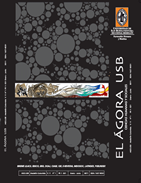Los autores y autoras también se adhieren a la licencia creative commons (4.0 https://creativecommons.org/licenses/by-nc-nd/4.0/deed.es)
Atribución - NoComercial - SinDerivar 4.0 Internacional (CC BY - NC - ND 4.0)
Resumen
La investigación tiende a indagar por las condiciones psicológicas (obsesivas), socio – familiares, fisiológicas y emocionales de los estudiantes de la Universidad de San Buenaventura –Medellín de mes de agosto de 2010, que tienden a destinar parte de su tiempo a las Redes Sociales Virtuales y hacer una reflexión desde la Bioética frente al tema.
Palabras clave:
Referencias
Adler-Lomnitz, L. (1994). Redes sociales, cultura y poder. Ensayos de antropología latinoamericana. México: Miguel Ángel Porrúa.
Alonso Dávila, I. (1992). "Nada de Soledades: algunas notas sobre redes sociales entre Mujeres. El Casco Antiguo de Alicante. Años 40-50" Canelobre, (23-24): 199-208.
Barry Wellman, 1960.The Networked Individual: A Profile of Barry Wellman.
Barry Wellman, Wenhong Chen and Dong Weizhen, 2002. “Networking Guanxi." Pp. 221-41 in Social Connections in China: Institutions, Culture and the Changing Nature of Guanxi, edited by Thomas Gold, Douglas Guthrie and David Wank. Cambridge University Press.
Blasco, A. (1995). “La Familia En Navarra, Individualización o Redes Sociales” Documentación Social, (98): 121-148, 32 Ref.
Boff, L. (1996) Ecología: grito de la Tierra, grito de los pobres, Editorial Trotta, Madrid. Bogotá.
Boyd, J. P. (2000) “Redes sociales y semigrupos” Política y sociedad, (33) 115-112.
Breiger, R. L. (2000). “Control social y redes sociales: un modelo a partir de Calcagno E. (2010). Desarrollo a Escala Humana.
Cohesive. blocking R es el programa para calcular la cohesión estructural según el algoritmo de Moody-White (2003). Ese wiki provee numerosos ejemplos y un tutorial para utilizar R.
lizalde, A. (2002). Ética ambiental: la bioética y la dimensión humana del desarrollo sustentable. Valores y redes de solidaridad. Medellín: editorial, UPB.
Fowler, J. H. (10 February 2009). «Model of Genetic Variation in Human Social Networks» (PDF). Proceedings of the National Academy of Sciences 106 (6): pp. 1720–1724.
doi:10.1073/pnas.0806746106. http://jhfowler.ucsd.edu/genes_and_social_networks.pdf.
Freeman, L. C. (2000) “La centralidad en las redes sociales. Clarificación conceptual” Política y sociedad, (33) 131-148.
Freeman, Linton. 2006. The Development of Social Network Analysis. Vancouver: Empirical Pres; Wellman, Barry and S.D. Berkowitz, eds., 1988. Social Structures: A Network Approach. Cambridge: Cambridge University Press.
Fukuyama, F. (2001). Confianza, Atlántida, Madrid.
García Roca, J. (2001). En tránsito hacia los últimos. Crítica política del voluntariado. Editorial Sal Terrae, Santander.
Genes and the Friends You Make», Wall Street Journal, January 27, 2009.
Georg Simmel” Política y sociedad, (33) 57-72.
Gil, J. y Schmidt, S. (2002). Análisis de redes. Aplicaciones a las ciencias sociales. IIMASUNAM, México.
González, A. (1979). Crisis Ecológica y Crisis Social. Algunas alternativas para México. Editorial Concepto, México D.F.
Wellman, Barry. (1988). "Structural Analysis: From Method and Metaphor to Theory and Substance." Pp. 19-61 in Social Structures: A Network Approach, edited by Barry
Wellman and S.D. Berkowitz. Cambridge: Cambridge University Press. (see also Scott, 2000 and Freeman, 2004).
Granovetter, M. S. (2000). “La fuerza de los vínculos débiles” Política y sociedad, (33) 41-56.
Granovetter, Mark 2007. "Introduction for the French Reader," Sociologica 2: 1-8; Wellman, Barry. 1988. "Structural Analysis: From Method and Metaphor to Theory and Substance." Pp. 19-61 in Social Structures: a Network Approach, edited by Barry Wellman and S.D. Berkowitz. Cambridge: Cambridge University Press.
Grillo, E. (1999). Caminos Andinos de Siempre, PRATEC, Lima.
Hansen, William B. and Reese, Eric L. 2009. Network Genie User Manual. Greensboro, NC: Tanglewood Research.
Herrero, R. (2000). “La terminología del análisis de redes. Problemas de definición y de traducción” Política y sociedad, (33) 199-206.
Hinkelammert, F. (1999).E l Huracán de la Globalización. Editorial DEI. San
Hinkelammert, F. (1999). El Mapa del Emperador. Determinismo, Caos, Sujeto. Editorial DEI. San José de Costa Rica.
James H. Fowler and Nicholas A. Christakis. (2008). "Dynamic spread of happiness in a large social network: longitudinal analysis over 20 years in the Framingham Heart Study." British Medical Journal. December 4, 2008: doi:10.1136/bmj.a2338. Para aquellos que no puedan ver el original: Happiness: It Really is Contagious Retrieved December 5, 2008.
Wasserman, Stanley, & Faust, Katherine. (1994). Social Networks Analysis: Methods and Applications. Cambridge: Cambridge University Press.
Krebs, Valdis. (2000). "The Social Life of Routers." Internet Protocol Journal, 3 (December): 14-25.
Linton Freeman, (2006). The Development of Social Network Analysis Vancouver: Empirical Press.
Linton Freeman, (2006). The Development of Social Network Analysis. Vancouver: Empirical Press.
Llinás, R. (1999). “Cerebro y Ética” en Memorias. 2º Congreso de Bioética de América Latina y del Caribe. CENALBE, Santa Fe de Bogotá.
Luhmann, Niklos. (1996). Confianza, Anthropos, Barcelona.
Maslow, Abraham. (1989). El hombre autorrealizado. Hacia una psicología del ser. Editorial Kairos, Buenos Aires.
Maturana, H. (1995). “El origen de lo humano” en Humberto
Maturana y Sima Nisis, Formación Humana y Capacitación. Dolmen Ediciones, Santiago.
Maturana, H. (1995). La realidad: ¿objetiva o construida? I. Fundamentos biológicos de la realidad, Editorial Anthropos, Barcelona.
Maturana, H. (1995). La realidad: ¿objetiva o construida? II. Fundamentos biológicos del conocimiento, Editorial Anthropos, Barcelona.
Nadel, SF. 1957. The Theory of Social Structure. London: Cohen and West.
Pizarro, N. (2000). “Presentación del número especial de Análisis de Redes Recuperado del Internet el 02 de marzo 2011.
Restrepo, L. C. (1994). El derecho a la ternura, Arango Editores, Santafé de Rodríguez, A. y Morera, D. (2001). El sociograma. Estudio de las relaciones
Wasserman, Stanley, and Faust, Katherine. (1994). Social Network Analysis: Methods and Applications. Cambridge: Cambridge University Press.
Wellman, B. (2000). “El análisis estructural: del método y la metáfora a la teoría y la sustancia” Política y sociedad, (33) 11-40.
Wellman, Barry and S.D. Berkowitz, eds., (1988). Social Structures: A Network Approach. Cambridge: Cambridge University Press.
White, D. R. y Reitz, K. P. (2000) “Homomorfismos de grafos y semigrupos
White, H. (2000) “La construcción de las organizaciones sociales como redes múltiples.” Política y sociedad, (33) 97-104.




















